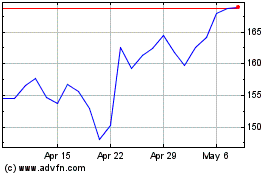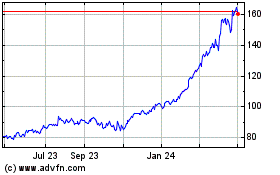Peltz Asks Little of GE, for Now
October 05 2015 - 8:20PM
Dow Jones News
By Ted Mann
Nelson Peltz's decision to bet $2.5 billion on General Electric
Co. gave a boost to the industrial giant's foundering stock price,
but just how long the good feeling lasts now rests on the company's
board and leadership.
The emergence of Mr. Peltz's Trian Fund Management LP as one of
GE's top 10 investors came without a typical activist investor's
arsenal of attack-like demands for board seats or calls to split up
the company. Instead, Trian had a rather light prescription: adding
$20 billion in debt to fuel more buybacks, reining in mergers and
acquisitions, and accelerating cost-cutting.
Shares of GE rose 5.3% to $26.83 Monday, adding $13 billion in
market value. It was the conglomerate's biggest one-day gain since
it decided in April to part ways with its massive lending business.
But the stock had surrendered all the gains since April amid
concerns that global growth is slowing.
Mr. Peltz is gambling that GE's share price hasn't reflected all
the work that has been done to streamline the company's industrial
businesses and exit the lending operation, said Jack De Gan, a
principal at investment manager Harbor Advisory, which owns GE
shares. "I'm not really sure how many new ideas he can inject and
how much more he can expect them to do."
GE Chief Executive Jeffrey Immelt is in the midst of reshaping
the conglomerate to jump-start its stock price that is 32% below
when he started in 2001. Mr. Immelt has adopted moves long sought
by investors, such as exiting the bulk of GE's finance arm, selling
off GE's slow-growing appliance business and cutting corporate
expenses to improve margins. Many of those moves have won plaudits
from analysts but have done little to boost GE's stock price, which
hasn't crossed $30 since the financial crisis.
The investment by Mr. Peltz's Trian followed years of
cultivation by GE and Mr. Immelt. While Mr. Peltz was building his
position in GE this year, he visited the company's facilities and
met with business-unit leaders. Mr. Peltz never briefed the full GE
board on his plans for the company, though Trian had conversations
with John J. Brennan, GE's lead independent director and the former
CEO of mutual fund Vanguard Group, according to a person familiar
with the talks.
GE has 16 directors on its board but just four directors that
were appointed before Mr. Immelt took on the role of chairman in
2001. Mr. Brennan joined the board in 2012 and was named lead
director last year. He has increased the company's engagement with
its investors, holding approximately 70 analyst and investor
meetings with GE leadership present in 2014, according to GE's
annual report.
Mr. Peltz's relationship with GE goes back several years. Mr.
Immelt approached Mr. Peltz in 2007 to join GE's board then, but it
didn't happen. Two years ago, Mr. Peltz was invited to address GE
corporate officers, a meeting GE says wasn't about activism but
about business in general.
Mr. Peltz has weighed in to praise Mr. Immelt's leadership in
the media, defending him against critics who charge that GE's stock
has lagged behind under his stewardship.
Much of Mr. Peltz's investment thesis, laid out in an 81-page
slide presentation, was consistent with other research about the
company this year. GE has strong growth prospects and leading
positions in its three biggest industrial businesses--power
turbines, jet engines, and medical scanners. And it is quickly
shedding the lending business that had been the primary deterrent
to its stock.
"I don't think Trian is the first to tell them to lever up on
the industrial debt by $20 billion, and certainly there will be
enormous capability to go even further than that," said Jack
Murphy, a portfolio manager at Levin Capital Strategies L.P., which
holds 10 million shares of GE, its largest industrial holding.
Trian and GE didn't mention changes to the industrial portfolio
in announcing Mr. Peltz's investment. Julian Mitchell, an analyst
for Credit Suisse, ventured that the arrival of Trian could prompt
GE to dispose of businesses that have lagged behind, like its
lighting and energy-management units, or undertake a deeper
shake-up in its health-care division.
Mr. Mitchell, who has a target share price of $31, seemed to
agree with Trian's investment thesis that borrowing to buy back
shares could boost GE's stock price. If the company were to borrow
$30 billion--$10 billion more than Trian suggested--that could push
GE's share price "into the high 30s level over the
medium-term."
David Benoit contributed to this article.
Write to Ted Mann at ted.mann@wsj.com
Subscribe to WSJ: http://online.wsj.com?mod=djnwires
(END) Dow Jones Newswires
October 05, 2015 20:05 ET (00:05 GMT)
Copyright (c) 2015 Dow Jones & Company, Inc.
GE Aerospace (NYSE:GE)
Historical Stock Chart
From Mar 2024 to Apr 2024

GE Aerospace (NYSE:GE)
Historical Stock Chart
From Apr 2023 to Apr 2024
